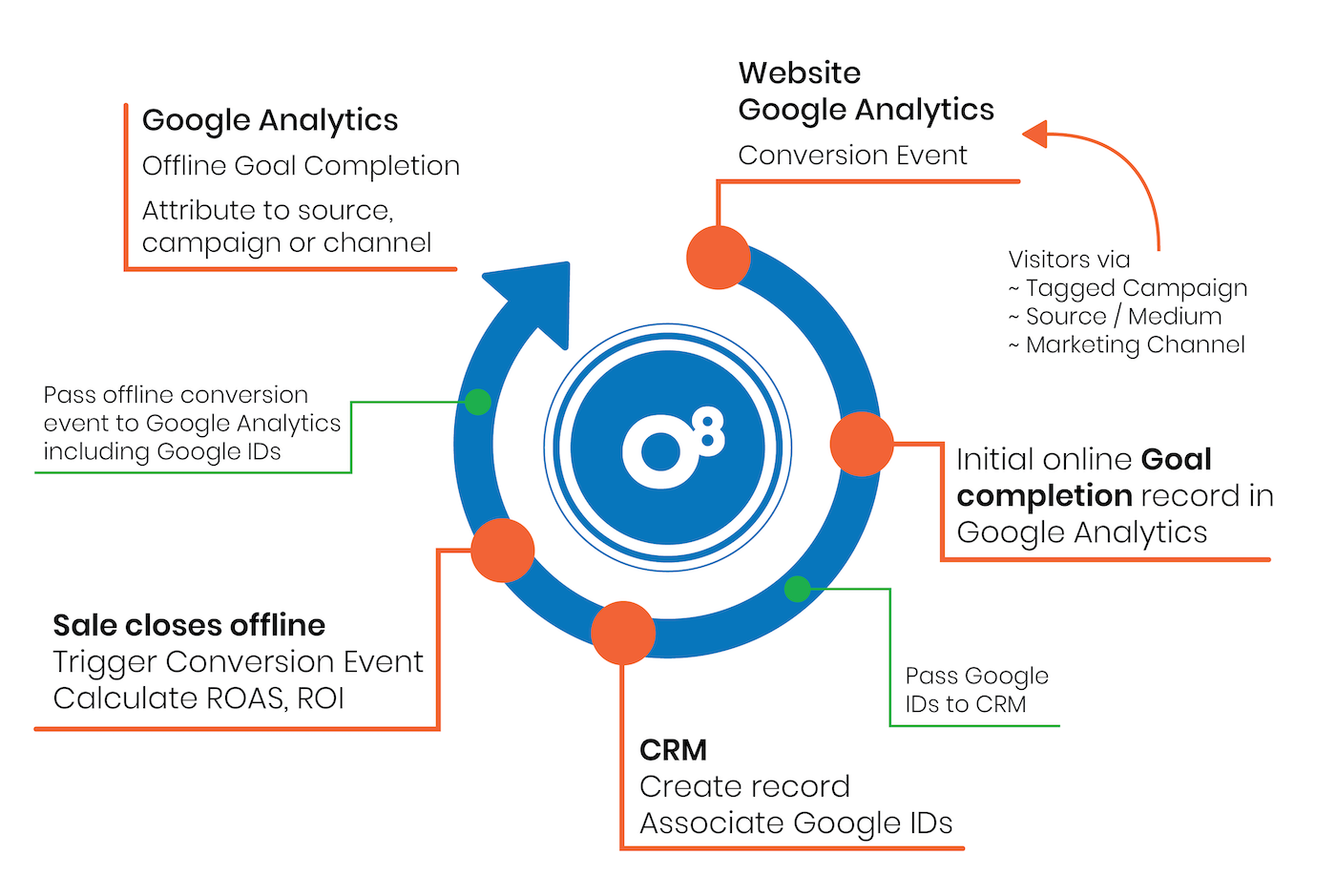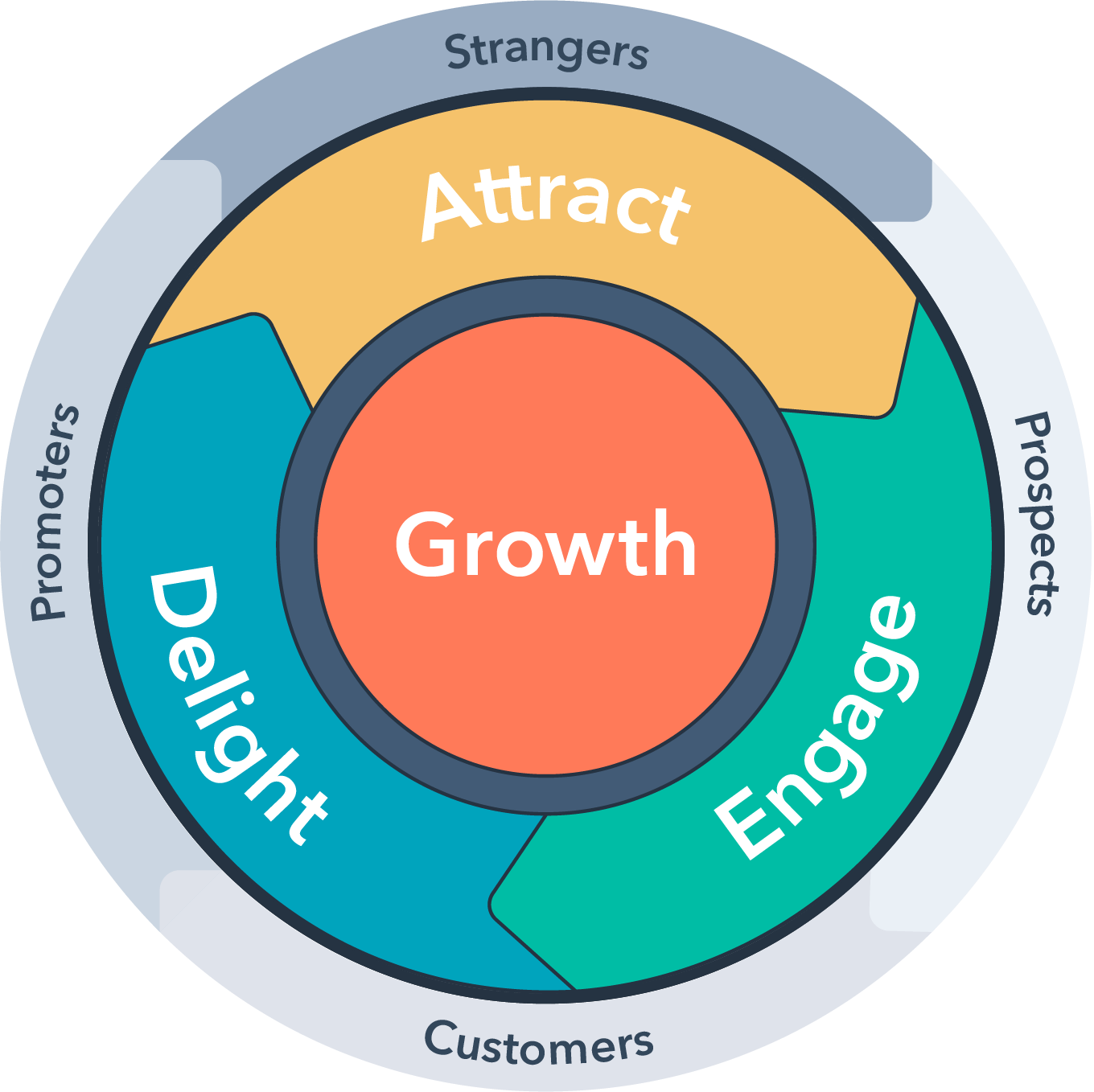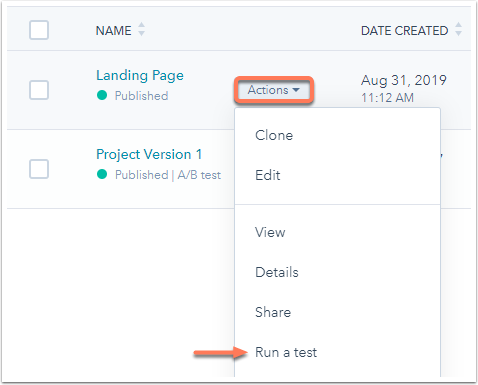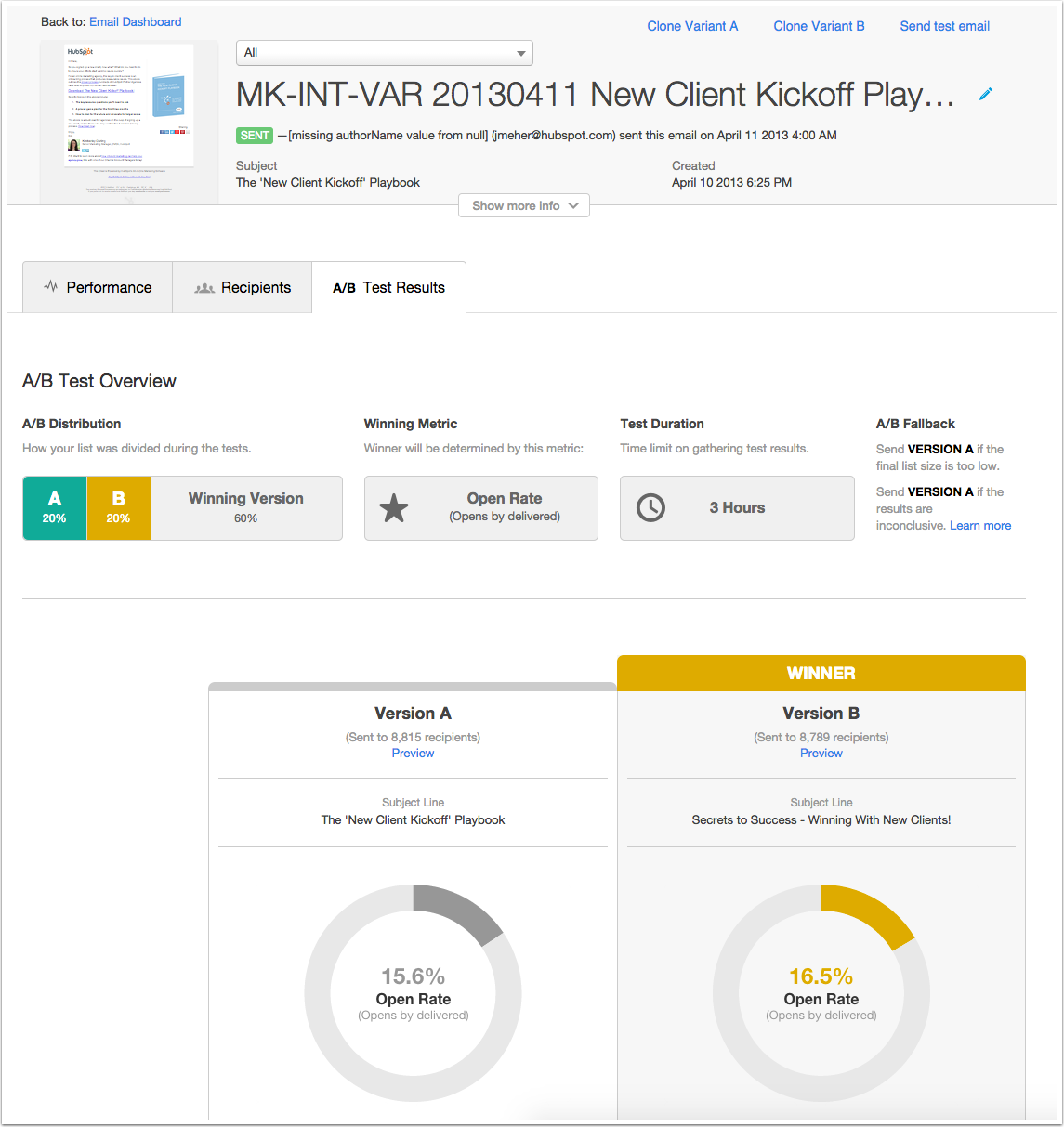Closed-Loop Marketing: The Guide, Using Hubspot as an Example

What Is Closed-Loop Marketing (CLM)?
Simply put, closed-loop marketing (CLM) gives marketers visibility to see the marketing efforts that lead to sales. A related concept is "attribution." It helps marketing teams measure which marketing campaigns are most successful, and why. When the sales team communicates its results to the marketing team, and marketing then tests new ideas to improve its marketing campaigns, generating better leads to share with sales, the "closed-loop" system generates a virtuous cycle.
The goal is to eliminate guesswork. The fewer the questions team members have, the less they have to guess about the best way to get results. For example, let’s say B’s Countertops is running a campaign. There are numerous questions to answer before B can say “we’re performing the best we possibly can.” The team needs to understand the consumers who comprise the market, for example. One way the team at B’s Countertops can learn about the market is through market research. Another is by communicating with sales to find out what kind of consumers are most likely to make a purchase. B needs to establish that line of communication between sales and marketing to close the loop.
The benefits of closed-loop marketing include:
- Eliminates Guesswork
- Increases ROI by Decreasing Cost per Lead
- Increases CLV (Customer Lifetime Value)
- Helps the Team Perform
On the other end of the spectrum, “open-loop” businesses are full of employees who don’t have the information they need and find it difficult to get results. The more fractured the loop is, the less effective the marketing is likely to be.

HubSpot gives businesses much of the information needed to answer questions for the whole marketing team. It’s particularly useful for making data-backed decisions about funnels and webpages as they apply to the buyer’s journey.
The three stages of the buyer’s journey are as follows:
- Awareness Stage: The prospect has a problem or need. He may not know what the problem is yet, but is attempting to understand it.
- Consideration Stage: The prospect has given a name to a problem or need and is searching for solutions to it.
- Decision Stage: The prospect has an idea of how to tackle the problem and is considering different products or services with which to do it. This can be a long process, as there may be many viable options.
Campaigns shouldn’t always aim for direct conversions. Sometimes it’s best to start with awareness. Marketers should communicate with consumers according to the consumer’s stage in the buyer’s journey.
Let’s consider B’s Countertops again. Say Ryan doesn’t like the countertop in his new home. He doesn’t yet know what kind of countertop he wants or even what kinds are available, however. That means he’s probably around the beginning of the second stage. Ryan isn’t ready to go ahead and buy a product and might not respond well to communication that attempts to close the deal right away. Information about the kinds of countertops that are available might help him, though. An impressively written page explaining his options will inform him and give him a positive opinion of B’s, increasing the chances that he will choose B’s in the end.
Analytics tools like Google Analytics and HubSpot’s Website Analytics can help B’s marketing team figure out how well pages are doing in terms of pushing visitors to the next stage in the buyer’s journey and ultimately, through to the sale.
Here’s a HubSpot Analytics table showing how many contact form submissions and new contacts resulted from views (visits or sessions) of particular web pages.
This can be filtered to show landing pages, blog posts, or other types of content. When submissions or new contacts aren’t the goal, the bounce rate is a strong indicator of how well the content is working. HubSpot can be configured to track button clicks and other actions, as well. The idea is to continuously improve the results, and that’s easier when the loop is closed.
A marketer can break his pages down by stages of the buyer’s journey, or he can create a custom report to show the rate of transfer from each stage of the funnel to the next. It’s even possible to see an individual’s specific actions along the way. Here’s an excerpt from a customer’s history showing how he submitted a form and became a lead after viewing a page. Notice the timestamps in the upper-right corner of each entry.
There are similar features in Google Analytics and other applications. Not all are as simple to set up as HubSpot, however.
When a funnel weakness is identified, it can be difficult to find a good way to strengthen it. Often, marketers turn to A/B testing, which means testing one variation of a page versus another and comparing the data. Tools like Optimizely, Google Optimize, and HubSpot's CMS Hub simplify the process. A/B testing is a common CRO practice.
In HubSpot, navigate to Marketing>Website>Landing Pages. You can click on the Website pages tab to view those, as well. Then find the page to be tested against a new variant and hover over it. Click either More or Actions, and then click either Run a Test or Create A/B Variant.
Both versions of the page will then be displayed to visitors according to the “distribution” of them, which can be adjusted. Typically, 50% of visitors will be sent to one page while the other 50% will see the other page.
Select a “winning metric” by which HubSpot can judge the winner of the test, and set the duration of the test before going live. The results page looks something like this for an email test (yes, CMS Hub has different “winning metrics” for different types of content).
For an email test such as the one above, the tester chose to focus on the open rate. For a landing page test, he might pay attention to bounce rate, customer conversion rate, or other metrics. Keep in mind that the more visits that are logged, the stronger the data is. It’s usually not a good idea to base a decision on just a few visits. The example test above logged over 6,000 visits per page, which provides a strong indication of the variant that works best even though it only won by 0.9%. Sometimes the difference will be much greater.
Feedback received from the sales team (in closed-loop fashion) can help marketing decide on new content to test. For example, what if sales has found that 75% of the latest 2,000 leads are interested in getting quotes for marble countertops, the most expensive material B’s Countertops offers? Giving that insight to marketing would be helpful. Marketing could test a landing page with a subheadline saying “Ask About Our Marble Specialists” versus a page that doesn’t include a subheadline to find out which one generates conversions best.
Let’s take the feedback example above to the next level. What if B’s Countertops has a list of subscribers who have expressed interest in a particular kind of countertop material. The material they’re interested in has been tagged on each of their profiles, so there are different list segments for each material. B’s dynamically inserts different text into sections of page or email content depending on which segment is viewing it. Each segment sees different text, in other words. For leads interested in granite, a page might say “Thanks for expressing interest in our premium granite products” while for those who are interested in polished concrete, the page could say “You’ve chosen well. Polished concrete is trendy and cost-effective.”
In HubSpot, dynamic content can be designated for values in six categories:
- Country
- Device Type
- Referral Source
- Preferred Language
- Contact List Membership
- Contact Lifecycle Stage (subscriber, lead, qualified lead, etc.)
Here’s how this “segmentation” happens:
Values like country, device type, and referral source are automatically tagged to each visitor in most cases, thanks to cookies. HubSpot and other analytics tools use a tracking code that is published in the website code to do this. The process of installing the code is fairly simple for most websites.
The other values – language, contact list membership, and contact lifecycle stage – are tagged when site visitors take actions that qualify them. Usually, visitors become leads (a stage in the contact lifecycle) after filling out contact forms. For example, they may select a language such as Spanish, which segments them as Spanish-language speakers. They may sign up for a webinar about eco-friendly construction materials (another “B’s Countertops” example), which could segment them into an eco-conscious segment.
Sometimes leads aren’t automatically segmented, however. For example, leads from spontaneous word-of-mouth communication can’t be given a referral source automatically. Sales teams can ask leads how they found out about the company or product when the source isn’t available so that marketing doesn’t have to use generic copy for a group of leads that might be diverse in many ways. Closed-loop marketing is all about sharing this kind of helpful information. The result is that marketers know what paths are commonly taken by users in each segment from first contact to first purchase and beyond.
Over the years, the line between service and marketing has blurred. Educating customers, solving their problems, and promoting products or services to them can (and often do) occur simultaneously.
How do you ensure customer advancements are continuously in play? Why not include the service and support departments in the loop? They might have the most intimate, most “natural” relationship with the customer out of everyone in the organization, after all. Just as sales should provide insights to marketing and other departments, so should service.
Enhancing customer experience starts with solving their problems. Businesses that do that well have a head start on maximizing customer lifetime value. It’s important, then, to have a good ticketing system in place. HubSpot delivers that with Service Hub, but it also takes it a step further so that delighted customers can be leveraged and turned into promoters.
There are different ways to do that. Positive reviews can be displayed on webpages to increase conversion rates and enhance the SEO value of the content. Businesses can offer cash to happy customers that refer their friends. They can offer discounts to upsell or cross-sell current customers who are more likely to sign up because they’re satisfied. There are many creative ways to leverage customer satisfaction, but make sure to start by maximizing it.

Source: HubSpot
HubSpot does a lot. It’s a CRM, a CMS, an analytics tool, a chat app, a ticketing app, and an e-commerce management tool. A key benefit of HubSpot is that all of this is available as a package. It’s all there once the marketer has signed up. Signing up is probably the most difficult part of getting started with HubSpot due to the choices available. A business can subscribe to the CRM, Marketing Hub, Sales Hub, and Service Hub separately or opt for a bundle that includes all of them. As with any set of products, the individual apps seem overpriced compared to the suite.
Few solutions are as capable and as intuitive as HubSpot’s full suite, but there are alternatives. In general, applications that focus on one thing (e.g. sales management or content management) tend to be more sophisticated and more adaptable than applications that are tailor-made for a suite. But that’s not always a bad thing. Simpler solutions can be very intuitive, which can save the business lots of time and money.
Some popular brands that are comparable to HubSpot’s products are Salesforce CRM (sales), Drupal (CMS), Zendesk (ticketing), Marketo (analytics, automation, etc.), and Mailchimp (CRM, email marketing). Many businesses are experienced with a specific CMS, sales management application, or ticketing system and aren’t keen on switching. Therefore, they probably won’t be immediately attracted to HubSpot’s full suite and its costs. Most of the brands above in this paragraph can be used together to fulfill the needs of the business. Some integrate better than others, though.
As for full-suite solutions that at least include a CRM, CMS, and marketing tools, there are a few options. Salesforce and SharpSpring are examples. To directly compare every aspect of them wouldn’t be particularly helpful since they’re all updated frequently and because there are so many unique tools and features that have subjective utility and attractiveness. To make a decision, managers should prioritize the business’s needs and then check out what each solution offers, putting the most weight on the highest priorities.
There are many reasons a business might choose HubSpot. Here are a few:
- It’s All-In-One
HubSpot is a comprehensive, closed-loop marketing suite that’s relatively easy to set up and use.
- Great for Building Relationships
It’s great for businesses that want to segment visitors and stay in contact with them. HubSpot is built for businesses that not only want to generate leads or customers but who also want to turn them into evangelists. Test content for each segment and lifecycle stage to optimize at every step.
- Good Reviews, Frequently Recommended
It’s one of the most recommended platforms in digital consulting due to its comprehensive yet easy-to-use nature. It’s not uncommon to see agencies using HubSpot for themselves and also setting it up for clients and teaching them how to use it. We’re one of those agencies, in fact. HubSpot is a good fit for a range of business models. Its reviews at G2 Crowd and elsewhere are solid.
- Easy Setup and Maintenance
HubSpot closes the loop without the need to troubleshoot a bunch of software and tracking codes. It’s one of the simplest ways to gather valuable data and put it into use, in terms of both setup and maintenance. If a business can’t perform at its best with HubSpot alone, it may take just one additional solution to keep things running smoothly.
- Lots of Integrations
When some extra functionality is required, there are lots of integrations available in the HubSpot “ecosystem.” Some common examples:
HubSpot Salesforce Integration
- Sync data or choose data types not to be synced.
- Send data, lead scores, etc. automatically.
- Leverage contact details from Salesforce in HubSpot CRM.
- Import revenue data from Salesforce to HubSpot.
- Use the Salesforce features that HubSpot doesn’t have, like advanced reporting and customization.
HubSpot for WordPress
- Take advantage of HubSpot forms and chat from inside WordPress.
- Sync contact information and develop leads.
Facebook Ads & other PPC Integrations
- Bridge the gap between ad targeting and lead management.
- Align keywords and targeting with website content for a consistent narrative.
- Create ads inside HubSpot.
- It Has a Surprisingly Robust Sales App
While Salesforce might be the best choice if a lot of customization is needed, Sales Hub is more than a basic sales CRM. It includes an AI system similar to Salesforce’s Einstein, good chat and call integration, lead scoring, and processes that save time. As a sales rep at iContact puts it:
“It saves me a lot of time. I can just enroll a prospect in a sequence instead of creating reminders and sending manually. And I can see stats on what emails and sequences get the best results.”
>> Learn more about why HubSpot may be the right choice for you.
- It Can’t Solve Extremely Complex Problems
HubSpot won’t replace a dedicated team that solves extremely difficult data analysis problems. It isn’t a political consulting firm that will design a cutting-edge targeting system for an entire nation of voters, for example. It does, however, provide a convenient set of tools that can do what most businesses need to do in terms of marketing, sales, content, and even service.
- Its Individual Products Might Not Be a Fit
It doesn’t make sense for many businesses to pay for an individual HubSpot application (e.g. Sales Hub) in stand-alone terms due to the pricing. HubSpot is a suite and most of the time, it will be utilized as one.
- Not for Small Businesses
HubSpot might not be the best choice for a startup or small business. The subscription fees are flat and they’re not especially low. Competitors such as Salesforce offer rates per user, which start off much lower, for better scalability.
- Not for Already-Closed-Loop Organizations
When a business or organization is already functioning well in every respect – from generating traffic to extending customer lifetime value – switching to HubSpot would be a case of “fixin somethin that ain’t broke.” Stick with what works unless there’s a good reason to switch, because switching costs time and money.
- It’s Not WordPress or Drupal
HubSpot’s CMS Hub is best for editing and optimizing simpler websites. It has some great features, like HubDB, for advanced usage. But it’s not WordPress, which is so customizable it can seem like an entirely different application when it’s running on a bunch of integrations and plugins. For examples of different ways we use WordPress, check out our case studies here. HubSpot also isn’t Drupal, a good CMS to choose for advanced sites that need strong security. We’ve published some Drupal case studies here.
HubSpot gives businesses much of the information needed to answer questions for the whole marketing team. It’s particularly useful for making marketing-data-backed decisions about marketing funnels and webpages as they apply to the buyer’s journey.
The three stages of the buyer’s journey are as follows:
- Awareness Stage: The prospect has a problem or need. He may not know what the problem is yet, but is attempting to understand it.
- Consideration Stage: The prospect has given a name to a problem or need and is searching for solutions to it.
- Decision Stage: The prospect has an idea of how to tackle the problem and is considering different products or services with which to do it. This can be a long process, as there may be many viable options.
Campaigns shouldn’t always aim for direct conversions. Sometimes it’s best to start with awareness. Marketers should communicate with consumers according to the consumer’s stage in the buyer’s journey. Facilitating the customer journey will ultimately drive the salesforce.
Let’s consider B’s Countertops again. Say Ryan doesn’t like the countertop in his new home. He doesn’t yet know what kind of countertop he wants or even what kinds are available, however. That means he’s probably around the beginning of the second stage. Ryan isn’t ready to go ahead and buy a product and might not respond well to communication that attempts to close the deal right away. Information about the kinds of countertops that are available might help him, though. An impressively written page explaining his options will inform him and give him a positive opinion of B’s, increasing the chances that he will choose B’s in the end.
Analytics tools like Google Analytics and HubSpot’s Website Analytics can help B’s marketing team figure out how well pages are doing in terms of pushing visitors to the next stage in the buyer’s journey and ultimately, through to the sale.
Here’s a HubSpot Analytics table showing how many contact form submissions and new contacts resulted from views (visits or sessions) of particular web pages.
This can be filtered to show landing pages, blog posts, or other types of content. When submissions or new contacts aren’t the goals, the bounce rate is a strong indicator of how well the content is working. HubSpot can be configured to track button clicks and other actions, as well. The idea is to continuously improve the results, and that’s easier when the loop is closed.
A marketer can break his pages down by stages of the buyer’s journey, or he can create a custom report to show the rate of transfer from each stage of the funnel to the next. It’s even possible to see an individual’s specific actions along the way. Here’s an excerpt from a customer’s history showing how he submitted a form and became a lead after viewing a page. Notice the timestamps in the upper-right corner of each entry.
There are similar features in Google Analytics and other applications. Not all are as simple to set up as HubSpot, however.
[RELATED: Everything you need to know about Closed-Loop Marketing]
When a funnel weakness is identified, it can be difficult to find a good way to strengthen it. Often, marketers turn to A/B testing, which means testing one variation of a page versus another and comparing the data. Tools like Optimizely, Google Optimize, and HubSpot's CMS Hub simplify the process. A/B testing is a common CRO practice.
In HubSpot, navigate to Marketing>Website>Landing Pages. You can click on the Website pages tab to view those, as well. Then find the page to be tested against a new variant and hover over it. Click either More or Actions, and then click either Run a Test or Create A/B Variant.

Both versions of the page will then be displayed to visitors according to the “distribution” of them, which can be adjusted. Typically, 50% of visitors will be sent to one page while the other 50% will see the other page.

Select a “winning metric” by which HubSpot can judge the winner of the test, and set the duration of the test before going live. The results page looks something like this for an email test (yes, CMS Hub has different “winning metrics” for different types of content).

For an email test such as the one above, the tester chose to focus on the open rate. For a landing page test, he might pay attention to other customer data such as bounce rate, conversion rate, or other metrics. Keep in mind that the more visits that are logged, the stronger the data is. It’s usually not a good idea to base a decision on just a few visits. The example test above logged over 6,000 visits per page, which provides a strong indication of the variant that works best even though it only won by 0.9%. Sometimes the difference will be much greater.
Feedback received from the sales team (in closed-loop marketing strategy) can help marketing decide on new content to test. For example, what if sales has found that 75% of the latest 2,000 leads are interested in getting quotes for marble countertops, the most expensive material B’s Countertops offers? Giving that insight to marketing would be helpful. Marketing could test a landing page with a subheadline saying “Ask About Our Marble Specialists” versus a page that doesn’t include a subheadline to find out which one generates conversions best.
HubSpot does a lot. It’s a customer relationship management platform (CRM), a content management system (CMS), an analytics tool, a chat app, a ticketing app, and an e-commerce management tool. A key benefit of HubSpot is that all of this is available as a package. It’s all there once the marketer has signed up. Signing up is probably the most difficult part of getting started with HubSpot due to the choices available. A business can subscribe to the CRM, Marketing Hub, Sales Hub, and Service Hub separately or opt for a bundle that includes all of them. As with any set of products, the individual apps seem overpriced compared to the suite.

